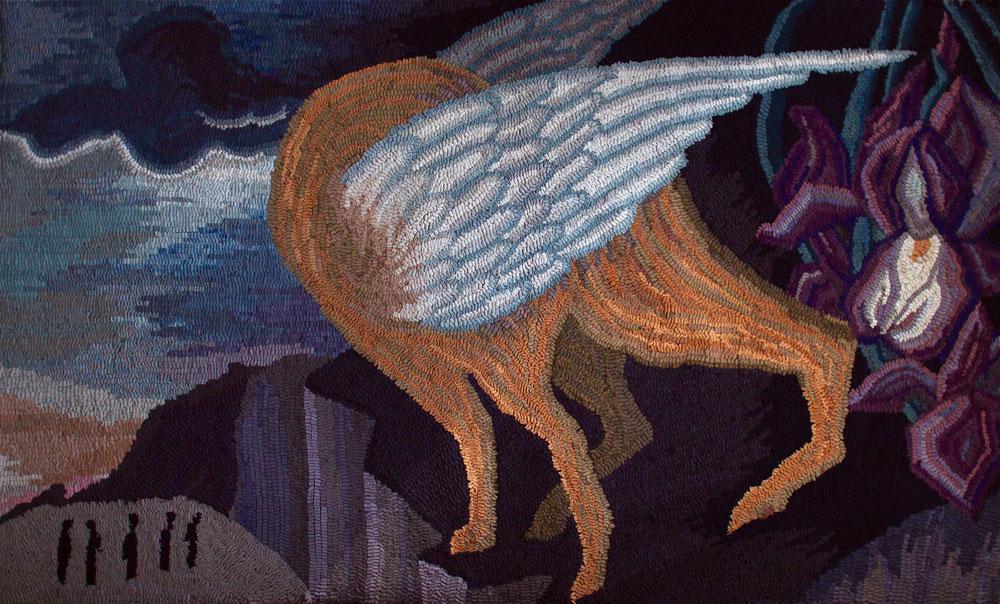At first glance, it seems like Heather Goodchild and Jérôme Havre have a lot in common.
Both are Toronto-based artists working with textiles; both have created figurative sculptures with this material; and both, in their joint exhibition “Fictions and Legends” at the Textile Museum of Canada, offer disturbing variations on the theme of a paradise lost.
But that’s where the similarity seems to end, at least in “Fictions and Legends”—a provocative pairing curated by the TMC’s Sarah Quinton.
Where Goodchild’s work in the show has a linear, carefully planned, centred and even ascetic or churchy quality, Havre’s conveys decentering, disorientation, camouflage, lushness, and bricolage. And while Goodchild’s prophetic tone seems to warn of a coming fall from grace, Havre reminds us that such failures already exist in our past and present.
Goodchild’s “Fictions and Legends” works are housed in her Wardens Tent, a large, temple-like structure screenprinted with a text that seems fit for a book of prayer.
Three doors in Wardens Tent lead to small rooms exhibiting rug-hooked scenes. In one scene, a dark, beast-like entity seems to obliterate the head of a woman as she lies down in a garden; in another, a black hand covers the head of an angel; and in another, a headless, winged beast looks out over a landscape populated by five small figures. All three scenes are biblically tinged, and they seem to suggest an evil that obliterates one’s ability to reason.
As in Goodchild’s past works The Wardens (2012) and The Revelations of Anna Ward Brouse (2007), the artist’s installation at the Textile Museum evokes a past idiom: specifically, that of a 19th-century spiritual society led by women. The other two doors in Wardens Tent lead to a passageway where one small, doll-like woman clutches a purse behind her back as she whispers into the ear of another. This passageway leads to another door and another room, where two similar figures engage in combat on a church altar while three other “dolls” look on.
Tensions between severity and liberty, and between hope and disappointment, run through Goodchild’s installation here. The figures are dressed in sober, conservative uniforms, but their long, girlish hair hangs loose. The text states that “where one is surrounded on every side by beauty, there is nothing that is divided,” yet fighting and deception is present. Given that Goodchild’s recent exhibition at Katharine Mulherin showed similar figures trying to deal with a coming flood, a warning to our climate-crisis-challenged times comes across.
Havre’s installation takes on the prospect of “the fall” differently.
The first way Havre’s installation differs from Goodchild’s is in its disorienting all-over-ness. The walls are covered in curving patterns of black, green and red that conjure camouflage, psychedelia or foliage. Lights installed on the floor illuminate these wall paintings from below, adding another level of disorientation. Nine figures are dispersed throughout the space; most are hung on clear strings so that they seem to float in the air, rather than stand on solid ground.
Havre’s figures are distinct from Goodchild’s in their product and process. Six from his Hybrid Series offer variations on quote-unquote “typical” human bodies: one figure has two sets of eyes, while another has two heads. One has large, elephantine ears, while another has no torso. Centaure melds the head and torso of a human with the lower half of a horse—albeit with human feet. And two figures from the Ornamental Objects Series present a bulbous, multicoloured body attached to human feet. In all cases, Havre’s figures seem to be bricolaged out of many small bits of cloth rather than being built from patterns.
Havre’s installation also has a very particular architectural reference point, and it is not the church or temple. Each of the room’s four walls bear a photograph from his Shelter series; these show small animal enclosures at a zoo, where concrete walls are painted with poor imitations of jungle foliage and branches are hung from wires in a pathetic re-creation of a forested environment. Each photograph is printed with selected hues off-register, so that, as on the walls, outlines in red, green and black loom through the space of each picture.
Regarding Havre’s installation as a kind of zoo, however, is very uncomfortable given the fact that the figures in his installation have many human features—and even more distressingly, given that they have brown skin and dreadlocks.
Havre himself is of Caribbean descent, and his figures, in a different installational context, might have seemed pure, imaginative flights of fancy conveying a sense of magic and play. Yet in this menagerie-like frame, they also speak to the heavy and very real phenomenon of “human zoos” which put people of colour on display in cages. Though these horrific institutions are often thought of as a long-gone, 19th-century-and-prior phenomenon, they extended into the 20th century. Even as recently as 2005, the Scotsman reported that a German zoo unveiled “plans to put grass-skirted black men in mud huts … to show off its elephants and rhinos in their ‘natural environment.’”
Overall, the artist pairing in “Fictions and Legends” gives viewers a lot to think about in terms of the stories we have been told—as well as how those stories might be lived now and manifested next, for good or ill.









